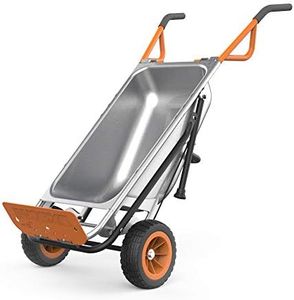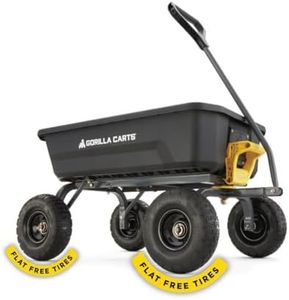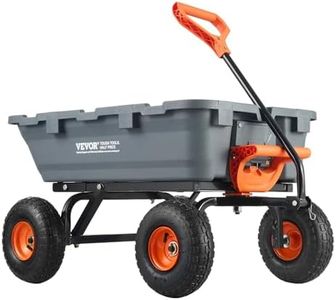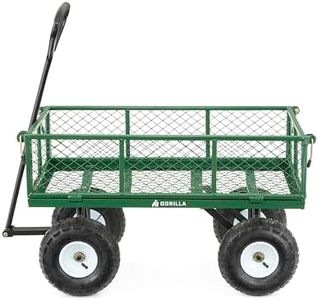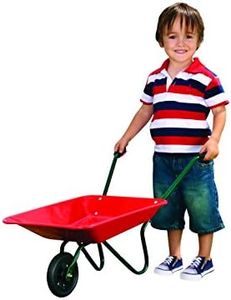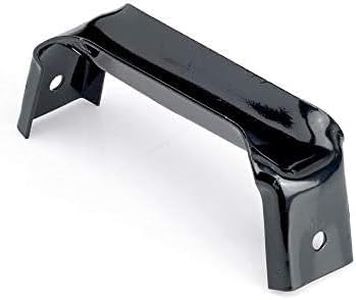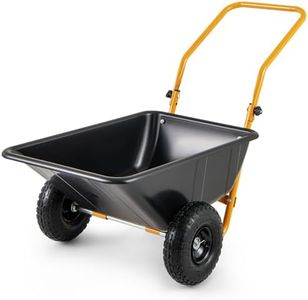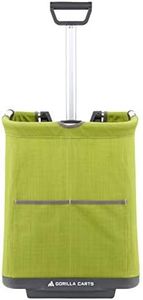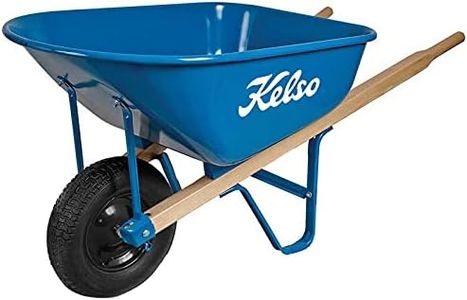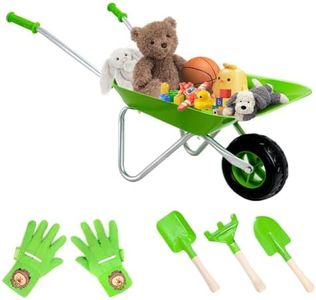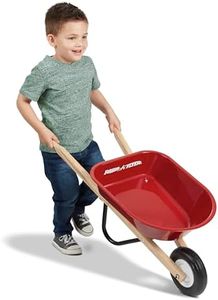We Use CookiesWe use cookies to enhance the security, performance,
functionality and for analytical and promotional activities. By continuing to browse this site you
are agreeing to our privacy policy
10 Best Wheelbarrows
From leading brands and best sellers available on the web.Buying Guide for the Best Wheelbarrows
Choosing the right wheelbarrow may seem simple, but there are several important features that can make a big difference in your gardening, construction, or landscaping tasks. Consider what you'll be using it for most often—moving soil in your garden, hauling heavy construction materials, or carrying lightweight items like leaves. The right wheelbarrow will feel balanced, be easy to maneuver, and have enough capacity for your needs without being too heavy to push when fully loaded.Tray MaterialThe tray is the main container of the wheelbarrow, and it's typically made from steel, plastic, or sometimes wood. Steel trays are very durable and can handle heavy, abrasive materials, making them great for construction work. However, they may rust over time if left outside. Plastic trays are lighter, easy to move, and won’t rust, but they may crack under heavy or sharp loads. Wood trays are less common and mainly used for decorative purposes or light gardening. Choose the material based on whether you’ll be hauling heavy, rough items or lighter, softer loads. For general gardening, plastic is often enough, while steel is better for tough jobs.
Capacity (Volume and Weight)Capacity refers to both how much the tray can hold (usually measured in cubic feet or liters) and how heavy a load it can handle. Wheelbarrows range from small models that hold about 2 cubic feet and a hundred pounds, to large ones over 6 cubic feet that carry several hundred pounds. If you're only moving leaves, compost, or mulch, a smaller model is fine and easier to handle. For hauling rocks, bricks, or soil, a larger, higher-capacity wheelbarrow is more efficient, but remember it will also be heavier to push when full. Consider the size and frequency of your jobs: regular heavy lifting calls for higher capacity, occasional light work can do with less.
Number of WheelsWheelbarrows generally come with one wheel or two. A single wheel in front is traditional and gives more maneuverability, especially on uneven terrain or tight spaces, but it can tip easily if you’re not careful with heavy loads. Two-wheel designs are more stable and less likely to tip, making them a good choice for those concerned about balance and for carrying very heavy or bulky items over flat ground. However, they’re harder to turn on a dime and struggle on rough ground. Think about your own strength and the surfaces you’ll work on: urban yards and flat gardens may benefit from two wheels, while rougher or trickier areas favor a single wheel.
Handle Design and MaterialHandles are what you use to lift and guide the wheelbarrow. They can be wood, metal, or plastic, and may come in straight or ergonomic (sometimes looped) shapes. Wooden handles are comfortable and absorb shock but may wear out if left outside. Metal handles are strong and durable, but they may be cold or hard on the hands. Ergonomic designs can make lifting and dumping easier, especially for those with less upper body strength. If ease of use and comfort are important, pick ergonomically shaped handles and consider one that is coated or padded.
Tire TypeTires come in two main types: pneumatic (air-filled, like a bicycle tire) and solid (made from hard rubber or plastic). Pneumatic tires provide cushioning and roll smoothly over rough ground but can go flat and require occasional air. Solid tires can’t go flat and need no maintenance, but can be harder to push over uneven terrain. If you work mostly on soft or bumpy ground, a pneumatic tire will be easier on your arms. For hard, smooth surfaces, or if you don't want to worry about punctures, a solid tire is a good choice.
